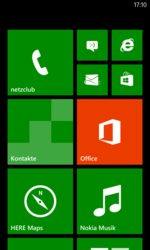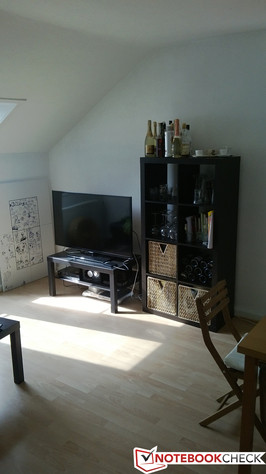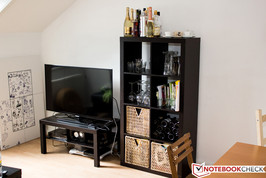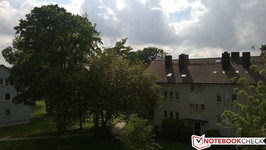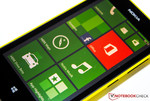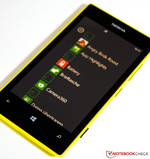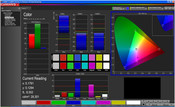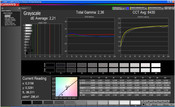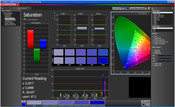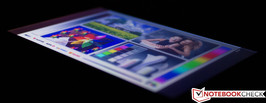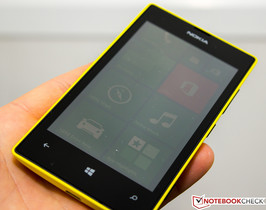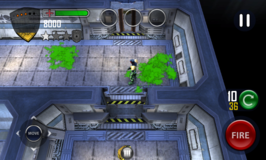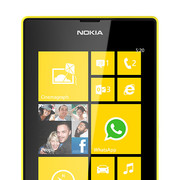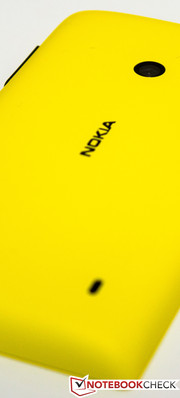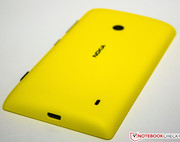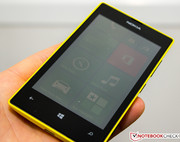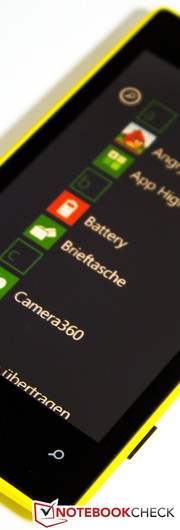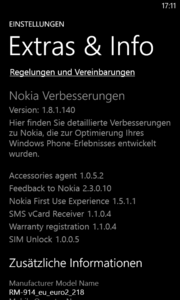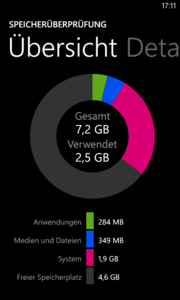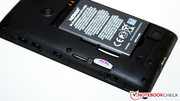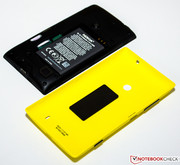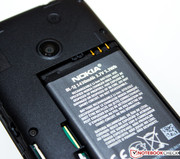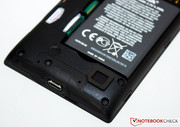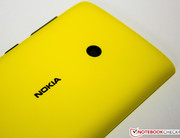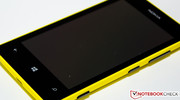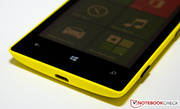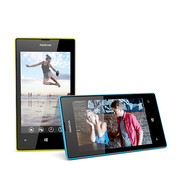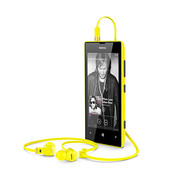Review Nokia Lumia 520 Smartphone
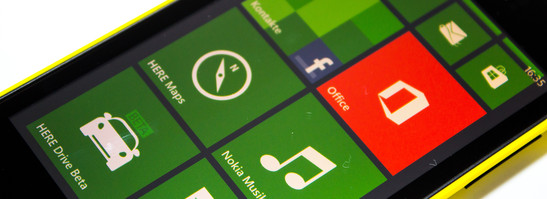
For the original German review, see here.
The Lumia 520 is to enhance Nokia's to-date successful Windows 8 product line by another affordable entry-level model. We recently had a very satisfactory smartphone from the low-budget sector in our hands with the Lumia 620. Our test device is 0.2 inches bigger and is sold for less money. The SoC (system-on-a-chip) has not been modified seeing that the Qualcomm Snapdragon S4 MSM8227 with a clock rate of 1 GHz is installed again. The working memory capacity of 512 MB and the Adreno 305 GPU have not been replaced either. The IPS screen has a resolution of 800x480 pixels and the Lumia 520 can fall back on 8 GB of internal storage. The most striking difference between both Nokia models is the RRP. The price of our test device was reduced by 70 Euros (~$92) to 199 Euros (~$260). We summarized whether Nokia's Lumia 520 features more buying incentives in this review.
Case
Nokia already proved that low prices do not equal inferior build quality with its Lumia 620. The bright yellow test device makes a similar impression. Its quality is of a very high standard. This is seen in the extreme stiffness and pressure resistance. The entire back cover is made of matte polycarbonate and can be completely removed. The physical buttons are implemented in the cover and can also be replaced when the cover is exchanged. A micro-SIM slot and micro-SD slot are underneath the hood.
The display's edge is a bit higher and is to prevent scratches on the touchscreen. With a size of 119.9 x 64 x 9.9 mm (~4.72 x 2.52 x 0.39 inches), the low-budget device is wider and longer than the Lumia 620 (115.4 x 61.1 x 11 mm/~4.54 x 2.41 x 0.43 inches) but roughly on a par with the Windows Phone 8S contender from HTC (120.5 x 63 x 10.3 mm/~4.74 x 2.48 x 0.41 inches). The weight difference to both latter models is also only 3 grams (~0.1 ounces) and thus only noticed when placed on a scale.
Connectivity
Just like most technical specs, the connectivity and interfaces of the Lumia 520 barely differ from the Lumia 620. The internal storage capacity is 8 GB and can easily be expanded via a micro-SD card.
Three physical buttons are distributed around the smartphone and three soft keys are implemented below the touchscreen. One of the hardware buttons is the volume rocker on the casing's right. The standby button is right below that and thus easy to reach. The compulsory camera shutter release is located another centimeter toward the bottom. The casing's left does not sport any buttons and only the 3.5 mm jack is on the top. We find the micro USB port for recharging and connecting to a computer on the bottom's center.
Software
Windows' latest operating system is also used here. We exhaustively reported about the available features and control concept of Windows Phone 8 in the reviews of Nokia's Lumia 620, 820, 920 and HTC's Windows Phone 8X. Since our test device does not have any new features, we would refer to the named test devices for more information.
Communication and GPS
Buyers expecting the newest wireless technologies, such as an NFC module, should keep in mind that the Lumia 520's street price is currently below 200 Euros (~$262). Despite that, the Wi-Fi module supports 802.11 b/g/n and Bluetooth version 3.0. The transmission and reception performance of both modules is satisfactory and stable. The device is UMTS-ready for mobile Internet on the go. The downstream rate is as much as 21.1 Mbit/s and an upstream of 5.76 Mbit/s is possible providing that the network load in the cell allows this.
The installed aGPS receiver is available for Nokia's "Here Maps" or "Here Drive Beta" software. The Satfix even works indoors and exhibits a high grade of stability. The connections remain stable and supply a satisfactory navigation result.
Cameras & Multimedia
The front-facing camera still found in the Lumia 620 has been omitted in our test device. Considering the awful pictures that the small camera shot, Nokia's decision is easy to understand. Consequently, the Lumia 520 only has a camera on its back. It has a resolution of 5 MP and an aperture of f2.4 at a sensor size of 0.25 inches. There is no LED flash. The fixed focal length is 28 mm and thus only a digital zoom is available. The lens can supply a focused picture at a minimum object distance of 10 cm (~3.9 inches).
Outside, no image noise is noticed using the primary camera. However, the camera cannot display both object zones with homogeneous brightness. Thus, the overall picture is too dark, particularly when compared with the reference camera. The sensor struggles with the same issue indoors. A visible noise starts to develop in the upper third of the picture. On a positive note, objects are usually sharp. An additional flash could improve the result in poorly lit rooms.
Accessories and Warranty
In contrast to the Lumia 620, our test device does not include an in-ear headset, but an on-ear headphone. The difference is not only an issue of wearing comfort. The on-ear model is more difficult to secure and it does not supply a good sound due to its open design. We also found a power supply unit, a USB cable and a quick start guide in the box.
A 24-month warranty is included for the primary device. A shorter warranty period of 12 months is given on the accessories and power supply unit. The battery is covered for only 6 months.
Input Devices and Controls
The capacitive touchscreen responds to inputs accurately and with an adequate speed. Compared with the Lumia 620, the screen is 0.2 inches bigger (5 mm in the diagonal) and thus offers a bit more room on the screen although the resolution has not changed. We did not notice a significant difference in the virtual keyboard's use compared to other Lumia devices.
Display
The 4-inch screen has a resolution of 800x480 pixels (WVGA) and uses IPS technology. The screen can reproduce 16.7 million colors and a color depth of 24-bits. The combination of resolution and screen size results in a pixel density of 233 dpi. The Lumia 620 manages 245 dpi due to its small screen. Apple's iPhone 5 accomplishes 343 dpi in this point with the same screen size.
The very bright screen in the Lumia 620 is obviously better than the 520’s, which achieved an average brightness of 287.1 cd/m². The screen in HTC's contender is also approximately 40 cd/m² brighter but has a 4% poorer illumination (test device's illumination: 92%)
| |||||||||||||||||||||||||
Brightness Distribution: 92 %
Center on Battery: 300 cd/m²
Contrast: 577:1 (Black: 0.52 cd/m²)
The black value of 0.52 cd/ m² is on a par with the Lumia 620. The device achieves a contrast of 577:1 due to the lower illumination. Consequently, the screen in the Lumia 620 excels with superior rates, which is another difference between the two, allegedly identical, devices.
We were pleased with the grayscale curve. It is consistently on the level of the ideal line. The Delta E 2000 rates of blue and magenta were not as pleasant since they were far from an acceptable result. The color saturation also shows that red and blue are too prominent.
Outdoor Use
The contrast is middling and the average brightness could be higher because the content is only legible to a moderate extent alongside the reflective surface. We also had the impression that the touchscreen was even more susceptible to fingerprints than other smartphones.
Viewing Angles
For technological reasons, the test device's viewing angles are the same as in the older model.
Performance
Following the motto "never change a winning team", Nokia decided to use the successful Lumia 620 as a standard and not to replace the main hardware components. Thus, Qualcomm's SoC dubbed Snapdragon S4 MSM8227 does the job. The two-processor cores clock with 1 GHz and use a working memory of 512 MB.
We have often observed that Windows' Phone 8 does not need as powerful hardware as Android-based devices in order to run smoothly on the system. The Lumia 520 again confirms this impression. All applications open immediately and the entire experience is agreeably smooth.
We performed browser-based benchmarks in order to compare the performance with other devices. The results were very sobering. In the past, we often discovered that Windows Phone 8 devices supply poorer performance rates in the tests but nevertheless work efficiently.
| Google V8 Ver. 7 - Google V8 Ver. 7 Score (sort by value) | |
| Nokia Lumia 520 | |
| Nokia Lumia 620 | |
| HTC Windows Phone 8S | |
| HTC One SV | |
| Apple iPhone 5 | |
| HTC One | |
| Browsermark - --- (sort by value) | |
| Nokia Lumia 520 | |
| Nokia Lumia 620 | |
| HTC Windows Phone 8S | |
| HTC One SV | |
| Apple iPhone 5 | |
| HTC One | |
| Sunspider - 0.9.1 Total Score (sort by value) | |
| Nokia Lumia 520 | |
| Nokia Lumia 620 | |
| HTC Windows Phone 8S | |
| HTC One SV | |
| Apple iPhone 5 | |
| HTC One | |
| Mozilla Kraken 1.0 - Total (sort by value) | |
| Nokia Lumia 520 | |
| HTC Windows Phone 8S | |
| HTC One SV | |
| Apple iPhone 5 | |
| HTC One | |
| Octane V1 - Total Score (sort by value) | |
| Nokia Lumia 520 | |
| HTC Windows Phone 8S | |
| Apple iPhone 5 | |
| HTC One | |
* ... smaller is better
The Lumia 520 scored lower than the competing products in all browser tests. We used cross-platform comparisons for analysis. HTC's One SV is based on the Android operating system and sports the same SoC and HTC's One is the flagship in the Android division. Apple's iPhone 5 represents the iOS devices.
The low-budget smartphone naturally does not have much of a chance here. HTC's 8S and the Lumia 620 were used for a direct comparison based on Windows' platform. The performance difference dropped to a minimum although both devices scored marginally better.
Videos & Games
We ventured to directly compare the Lumia 520 with Sony's Xperia J, which is an Android device. Both SoCs are virtually identical although the Xperia J only sports the Adreno 200. Playing videos on the Android contender is only inconveniently possible and delivers a poor result. We used the same trailers on the Lumia 520 and everything worked perfectly right away. There were no problems with the MKC container files that were rendered with a data speed of up to 6100 kBit/s.
A similar result is seen in the gaming performance. The action track "Dredd vs. Zombies" did not produce any failures or loading delays. The SoC apparently has enough performance reserves for multimedia applications.
Speech Quality
We do not have many complaints in this test segment. The result is very positive. The called party sounded clear and was clearly understood and there was no trace of noise interference. However, considering replacing the included on-ear headset with a higher quality headset might be worthwhile if value is placed on high quality and good sound.
Emissions
Temperature
The technical evolution was on Nokia's side in the thermal design of the Lumia 520. The test device reached lower temperatures than the Lumia 620 in every scenario. We measured an average of just 34.2°C (93.56 °F) during load on the front in our test course (Lumia 620: 37.6°C / 99.68 °F). This is repeated in idle mode. On the back we measured an average of 26°C (78.8 °F). The power supply reached a load temperature of up to 40.1°C (104.18 °F) and idle temperature of only 29.2 °C (84.56 °F). All ascertained temperatures were within an absolutely safe range.
(+) The maximum temperature on the upper side is 37.1 °C / 99 F, compared to the average of 35.2 °C / 95 F, ranging from 21.9 to 247 °C for the class Smartphone.
(±) The bottom heats up to a maximum of 41.6 °C / 107 F, compared to the average of 34 °C / 93 F
(+) In idle usage, the average temperature for the upper side is 27.3 °C / 81 F, compared to the device average of 32.9 °C / 91 F.
Speakers
The mono-speaker is not covered when the smartphone is placed on an even surface due to the device's rounded design. Although the speaker's opening on the back cover is smaller than the component, it supplies a surprisingly loud sound. Playback is good at 50% of the maximum volume. The sound is clear but an audible, tinny sound starts to develop. It becomes very audible with increasing volume and affects the sound massively. External speakers should consequently be used at higher volumes.
Energy Management
Power Consumption
We looked closer at the Lumia 520's power consumption using the Voltcraft VC 940. Its low power consumption is quickly noticed when compared with HTC's 8S and Lumia 620. All three devices are based on the same SoC and feature a screen diagonal from 3.8 to 4 inches. The varying power consumption is presumably due to the screens' different brightness rates. The Lumia 520 is satisfied with rates between 0.8 and 2.2 Watts in idle. HTC's 8S and the Lumia 620 already consume 1.2 Watts in maximum energy-saving mode. The difference becomes even more obvious when the SoC is fully loaded. HTC device's power consumption ranges from 3.0 and 4.1 Watts. Nokia's device tops that and consumes up to 4.4 Watts. Our test device is very energy-efficient in this test with 2.6 Watts during load. The following part is even more interesting because it reveals the relationship with the battery capacity and whether a time advantage can be achieved.
| Off / Standby | |
| Idle | |
| Load |
|
Key:
min: | |
Battery Runtime
Compared with the Lumia 620, Nokia has increased the battery capacity by 130 mAh (0.5 Wh). This adds up to 1430 mAh. Full load was simulated using the "WP Bench Free" app. All wireless modules were enabled and the screen remained on over the test period. The low-budget device was drained after 2 hours and 42 minutes. The Lumia 520 was recharged in 2 hours and 30 minutes and could face the next test. We ascertained a runtime of 12 hours and 56 minutes in the practical Wi-Fi test, which is approximately 2.5 hours longer than from the Lumia 620. An equally positive result was recorded in the idle test scenario. The device lasted for a great 17 hours and 5 minutes until it shut down. Although it sports a stronger battery, HTC's 8S cannot quite compete with the Lumia 520 due to its higher power consumption.
Verdict
The Lumia 520 seamlessly fits itself into the lower end of Nokia's portfolio and supplies a great result in all tests. This is however always considering the retail price. It naturally cannot compete with the performance and equipment of a Lumia 920 or HTC One. The 0.2-inch smaller Lumia 620 currently is a bit more expensive but the buyer gets a brighter screen with a higher contrast. This however does not mean that the Lumia 520 is bad. The screen is its biggest distinctive feature because there are barely any noticeable differences in build or other hardware components. The hardware in both devices is ideal for everyday use and is also made for multimedia applications. Nokia also beefed up the battery runtime a bit and installed a stronger battery in the Lumia 520.
Our yellow test device is currently available for just under 190 Euros (~$249) in online stores. The low-budget device will certainly serve those well who want to try out the Windows Phone 8 segment for the first time.









